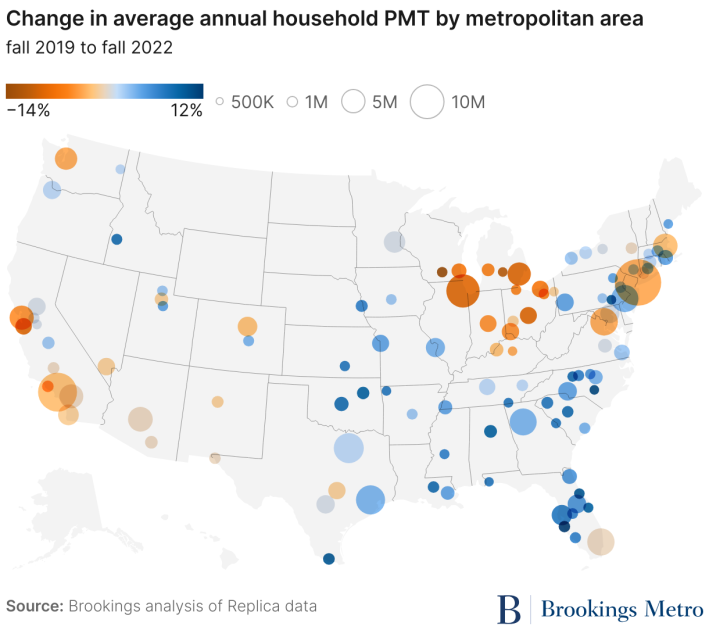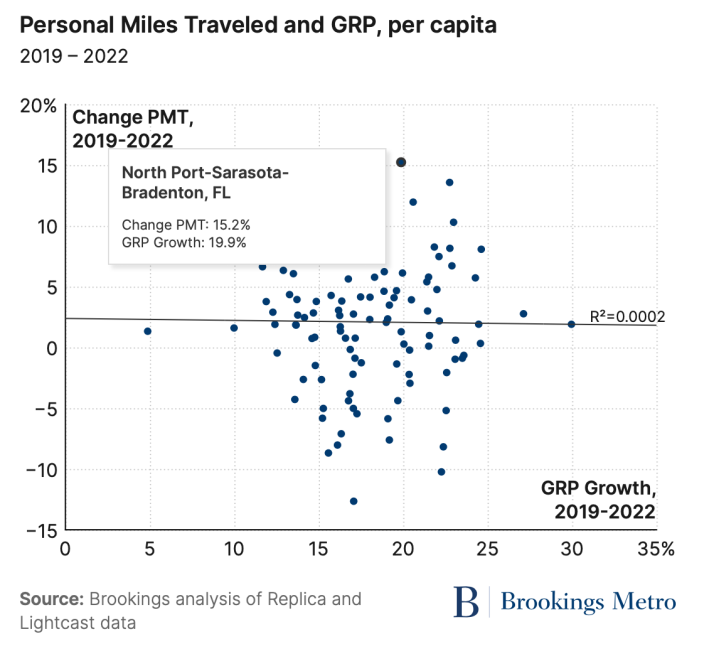The work-from-home revolution didn't necessarily revolutionize how much Americans travel, a new study confirms — but it did open up critical new opportunities for policymakers to influence how much of that travel is done in a car.
In a new study, the Brookings Institute and the big mobility data firm Replica confirmed that traditional work commutes dropped and errand-related trips increased throughout the day during the pandemic in each of America's 109 largest metro areas. Taken as a whole, U.S. travelers clocked roughly the same number of total miles travelled across all modes in the fall of 2019 as they did in the fall of 2022 — despite a nearly sevenfold increase in the share of work that's performed at home. The results bolstered some sustainable transportation advocates' long-held suspicions that telework wouldn't necessarily translate to a nosedive in national travel.
"Think of this through a kind of travel budget," said Adie Tomer, senior fellow at Brookings and the co-author of the report. "Folks are used to traveling a certain amount of time [every day], and then all of a sudden, they had far more time in their travel budget account. ... That seems to allow them to change their patterns around doing other tasks — most notably, errands."

At the local level, though, the data got far more complicated.
In some metros, "personal miles traveled" across all modes did go down during the pandemic — though in most cities, commuters' decisions to ditch the daily commute actually resulted in an increase in residents' total PMT. In the car-dependent metropolitan region around Sarasota, Fla., for instance, personal miles travelled skyrocketed 15.2 percent in three years, while in bike-friendly Madison, Wisc., it dove 12.7 percent.
Worse, no single variable that the researchers looked at fully explained these differences, including the relative concentration of telework-heavy industries from one metro to the next, changes in population over the course of the pandemic, or the varying levels of economic activity in each region.
The best explanation they could come up with was that in some cities, erstwhile commuters completed their flurry of midday errands at neighborhood businesses within a short walking distance of home — while in others, they took multiple, long drives to far-flung grocery stores, gyms, and appointments, rather than "chaining" all those errands together on the way to or from work like they did before.

What's clear even from those muddy findings, though, is that they complicate the emerging narrative that working from home is inherently a "greener" (or even simply less car-intensive) alternative — while also complicating questions about how transportation leaders should respond to the American workforce's new teleworking normal.
Just days after the release of the Brookings report, the Washington Post ran a breezy write up of a Cornell study that claimed "working from home full time may reduce a person’s carbon footprint by more than 50 percent" — a summary that some advocates said was misleading since the study was primarily based on the commuting patterns of a handful of Microsoft employees in the relatively walkable and transit-rich Seattle metro.
By contrast, the Cornell authors themselves emphasized that the emissions benefits of telework often wane when newly remote employees move to car-dependent areas, choose more fuel-intensive vehicles, do choose EVs but charge them off a dirty grid, or — as the Brookings researchers found often happens — trade car commutes for even lengthier errands done in that very same car.
"While remote work shows potential in reducing carbon footprint, careful consideration of commuting patterns ... vehicle ownership, and non-commute-related travel is essential to fully realize its environmental benefits," the Cornell authors concluded.
Switching from working onsite to working from home may reduce a person’s carbon footprint by more than 50 percent, according to a new study. https://t.co/6z6w07uwZw
— The Washington Post (@washingtonpost) September 25, 2023
The Brookings authors argue that policymakers need to be the ones to lead that "careful consideration" — and take action to make sure that work from home policies don't do more harm than good.
"Maybe working from home or hybrid work arrangements could impact vehicle emissions — but only if the other trips people are taking are shorter, or accessible through alternative modes of transportation," said Caroline George, who co-authored the Brookings study. "So that begs the question: are we designing neighborhoods to have the concentration of amenities that we need on a daily basis? Are we designing the transportation connections within those residential neighborhoods — not just in and out of downtown — to be accessible, safe, and welcoming to people?"
To do that, George argues that transportation leaders first have to stop hyper-focusing on the sporadically collected "journey to work" metrics that dominate national travel surveys, and start drawing on more granular, year-round mobility data that reflect where, when, and how Americans actually travel day-to-day. And that might mean looking at the kind of anonymized and aggregated cell phone records, credit card purchases, and other big-data sources that the Brookings authors used in their study.
"We are at a data deficit at the national public level," added Tomer. "And that can only be limiting our opportunities — whether it's where we plan investments, or how to reorient street space. ... It is so important that we have a national conversation [about this, and] fundamentally rethink [how we collect travel data]."
As that data comes in, one thing is growing increasingly clear: the assumption that Americans' traveling lives are centered on long commutes between sprawling suburbs and dense downtowns just isn't true, particularly in the work-from-home era. And if we're serious about addressing climate change and the other problems of excessive driving, we need to do more to give people mobility alternatives everywhere they might go.






